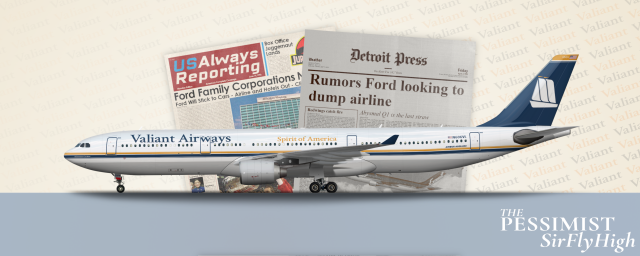
1994 Airbus A330-300
- Owner: ThePessimist (View all images and albums)
- Uploaded: Apr 10 2023 04:19 PM
- Views: 940
- Album Valiant Airways

The 90s were a time of great change for FAST. The failure of the Ray route overhaul had been an expensive stumble that convinced many Ford executives that the airline was more a boondoggle than stable and profitable enterprise. Even though the airline was extremely profitable, those periods were fleeting and far between. The vehicle market was one that moved on the scale of years allowing for careful and thorough long-term planning. Hospitality sector ventures like airlines and hotels required much more flexibility and the timescales of management could vary from quarters to weeks. It was a point of company pride to be able to make an advertisement that juxtaposed a new Ford sports sedan or Lincoln luxury cruiser next to a shiny new aircraft in gleaming Raybeam paint. This incentive was not enough to combat the difficulties of managing an airline and making a profit.
Political changes at the beginning of the last decade of the century made the case for retaining FAST in the Ford portfolio even worse. Since its inception, Ford had worried that its small fiefdom of FFC subsidiaries would attract the ever scornful eye of antitrust authorities. Previous administrations of both Republican and Democratic stripes had shied away from targeting Ford. However, Bill Clinton, famed saxophone player, made aggressive antitrust a cornerstone of his economic plan to beat Bush and banish Reagan era economic policy. Upon his victory, antitrust authorities began a not at all quiet series of investigations into alleged market concentration under the Ford and FFC banners. For Ford, this was the last straw. It was one thing to maintain a struggling sector of the company in hopes that it would find its way to profitability, but it was another to risk antitrust action to retain ownership of a struggling unit. Ford sought to head authorities off at the pass by jettisoning FAST, throwing off the Federal antitrust case, and then choosing which units they wanted to break off of the corporation instead of letting the government pick and chose which businesses they kept. Thus, Ford spent much of the summer of 1993 searching for a buyer for a medium sized American airline.
As it turned out, Ford was not the only corporate overlord feeling sour on the commercial passenger aviation sector. Ford’s original plan for FAST was absolutely to sell it off to another corporate entity more interested in managing an airline. Truthfully, Ford had believed that between the various American hotel giants like Marriott, Hilton, and Sheraton, all of whom were locked in fierce combat and had substantial experience in the hospitality industry, it wouldn’t be hard at all to shop FAST. This belief was misguided as economic headwinds and the condition of the airline made it a difficult sell. In the end, a small cadre of Ford executives who had remained steadfastly committed to the FAST project proposed a project to hold a public offering for the airline. The executives, led by Phil Skinner, resigned from their places on the Ford board, with handsome compensation packages of course, and opened a new holding company. The holding company, creatively named the Detroit-American Airline Board (DAAB), was fully owned by Ford but received full ownership of FAST’s assets and intellectual properties. DAAB was tasked with coordinating the IPO for the airline and selling all of Ford’s shares in the new corporation. One unexpected issue facing DAAB and Skinner was a name for FAST. Ford did not wish for the airline to continue using the Ford name or FFC branding and because the airline was not being acquired by a new holding company, it couldn’t simply be named for its new corporate overlord because Marriott Air Service Transport (MAST) was a reasonable name, but Shareholder’s Air Service Transport (SAST) did not work. To solve this problem, DAAB dug through the parts bin of FAST’s various intellectual properties and settled on a novel strategy. DAAB’s design and branding partners proposed either introducing an entirely new name, they suggested Synergy Airlines, or reviving the Valiant name which had applied to the majority of the airline’s assets before the Ford acquisition. As catchy as Synergy was, executives were convinced that leaning into what appeared to be a historic name and brand would set up the carrier for greater success. The airline had previously been VAD (Valiant Air Division) but consultants unanimously agreed that the Air Division branding was clunky and outmoded. Instead, Valiant Airways was born and a logo that paid homage to the original Valiant Steamship company’s maritime heritage was drawn up. Valiant Airways, under DAAB management, planned to operate as a relatively upscale legacy style carrier focusing the international network through hubs in Detroit, Dulles, and San Diego. Then, with a business model and brand identity, it became time to launch the IPO.
The initial public offering was not an unmitigated success, but it was also not a disaster. In the end, Ford hung onto almost 15% of the new company and carrier. Additionally, and quite annoyingly, Marriott did end up buying almost 25% of the carrier’s stock. The rest of the stock rolled out onto the market for a variety of interests from investment firms to individuals to buy. The DAAB board was elected to take up positions on the board for Valiant to start the carrier’s new chapter. Not wanting to blow the fledgling airline’s budget on paint, Phil Skinner decreed that most of the fleet should continue to wear a largely unmodified FAST livery for the first three years of the carrier’s existence during which Ford graciously allowed their former subsidiary to continue using FAST, Ford, and FFC intellectual properties. It was common to see an early Valiant aircraft in FAST’s Raybeam paint with a sticker on the tail somewhat covering the FAST wordmark with the new Valiant Schooner logo. New aircraft delivered to the carrier wore a new paint scheme that would start the new era in the airline’s branding. The first aircraft delivered to the new Valiant were Airbus A330-300s which had been the last order Ford had financed for FAST. These twinjets replaced many of the older Lockheed Tristars on domestic trunks and lighter international services. The new livery was a sharp departure from the 80s style which characterised FAST’s Raybeam. The simple lines of the three sail Schooner were complimented by an understated cheat below the windows. The colourscheme adopted VAD’s blue, cream, and gold for the modern era by introducing a sharp orange. N606VL, pictured above as Clipper Schooner as it appeared upon delivery, was only the third aircraft delivered new to Valiant. The new delivery A330-300s also featured the large Spirit of America text but paint crews refused to repaint existing aircraft with the large slogan text and eventually management agreed because only the first 15 A330-300s delivered featured these titles whereas the rest of the fleet had a much smaller title. This aircraft served much of its early life based in Detroit handling flights to the likes of Glasgow and Barcelona. It is still in operation today, although its now part of the select fleet operating South American services out of Orlando.
[Edit: Window Shades]
I find the background kind of distracting, but otherwise it´s great!
Nice A330
Thank you!
I find the background kind of distracting, but otherwise it´s great!
Thank you. I was excited about these newspaper mockups that I made and wanted to fold them in but I agree it's not the slickest/cleanest presentation. Here it is without the papers.


 Sign In
Sign In Create Account
Create Account












Nice A330